When you spot a String of Pearls cascading from a hanging pot, you’ll understand why trailing succulents have become the go-to choice for elevated displays. These fascinating plants don’t just save precious shelf space – they create living curtains of unique shapes and textures that can transform any room. You’re about to discover how fifteen distinctive succulent varieties can turn ordinary hanging baskets into eye-catching focal points that’ll have your guests asking for gardening tips.
Contents
- 1 1. String of Pearls
- 2 2. Burro’s Tail Succulent
- 3 3. String of Fishhooks Succulent
- 4 4. Trailing Jade Plant
- 5 5. Cascading Ruby Necklace Plant
- 6 6. Trailing String of Hearts
- 7 7. Monkey Tail Cactus
- 8 8. Knotted Chain Crassulata
- 9 9. Calico Kitten Succulent
- 10 10. Trailing Dolphin Plant
- 11 11. Dancing Bones Succulent
- 12 12. Hanging Rat Tail Cactus
- 13 13. String of Nickels
- 14 14. Fishbone Cactus
- 15 15. Peanut Cactus
1. String of Pearls
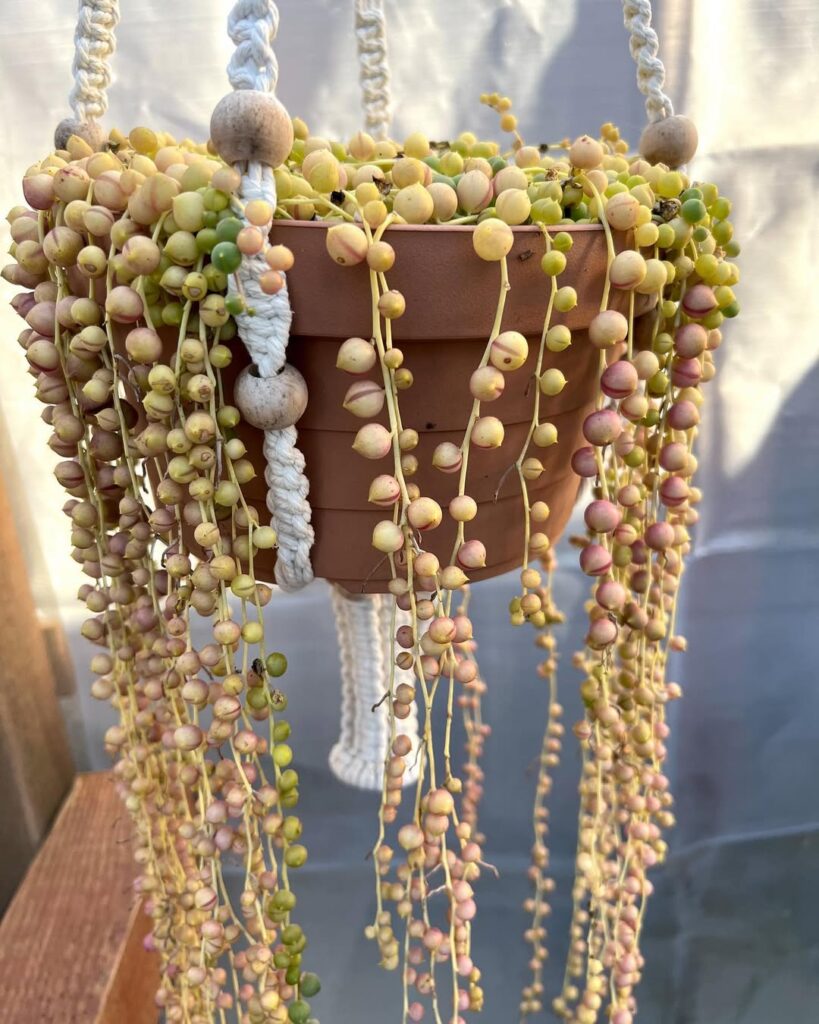
String of Pearls (Senecio rowleyanus) is a trailing succulent with distinctive pea-shaped leaves that cascade down from hanging containers, creating the appearance of a beaded necklace. This South African native can grow several feet long, making it perfect for hanging baskets and elevated planters. Its delicate stems carry small, round, green pearls that store water, and in summer, it produces tiny white flowers with a cinnamon-like fragrance.
- Light: Bright, indirect light; can tolerate some direct morning sun but needs protection from harsh afternoon rays
- Water: Allow soil to dry completely between waterings; reduce watering in winter
- Soil: Well-draining succulent or cactus mix
- Temperature: 70-80°F (21-27°C); protect from frost
- Humidity: Low to moderate; tolerates average household humidity
- Container: Hanging pot with drainage holes
- Fertilizer: Light feeding with balanced fertilizer during growing season
- Propagation: Easily propagated through stem cuttings
2. Burro’s Tail Succulent
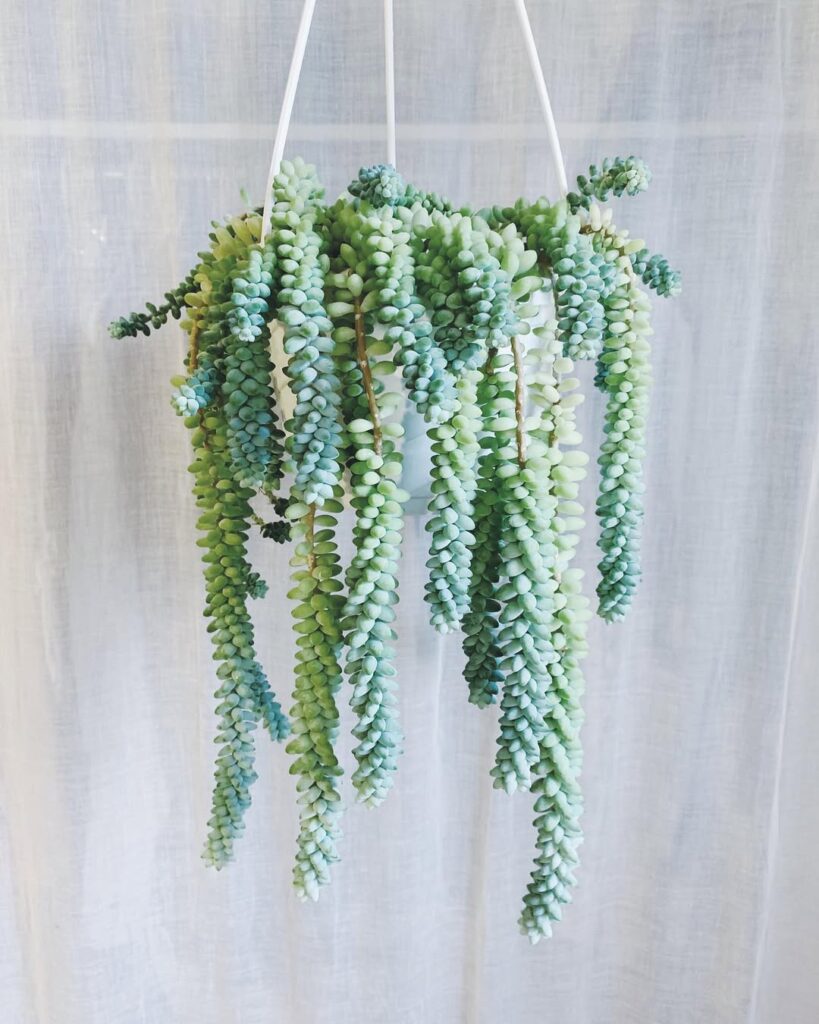
Burro’s Tail (Sedum morganianum) is a trailing succulent known for its long stems densely packed with plump, blue-green leaves that overlap like a braided rope. This Mexican native can grow up to 4 feet long, making it perfect for hanging baskets where its characteristic tail-like stems can cascade downward. Its leaves are delicate and prone to falling off when touched, but this also makes propagation easy as fallen leaves readily root to form new plants.
- Light: Bright, indirect sunlight; protect from intense afternoon sun
- Water: Water thoroughly when soil is completely dry; reduce watering in winter
- Soil: Well-draining cactus or succulent mix
- Temperature: 65-75°F (18-24°C); not frost tolerant
- Humidity: Low to moderate
- Container: Hanging basket or pot with drainage holes
- Fertilizer: Feed with diluted succulent fertilizer during growing season
- Propagation: Easily propagated from stem cuttings or fallen leaves
3. String of Fishhooks Succulent
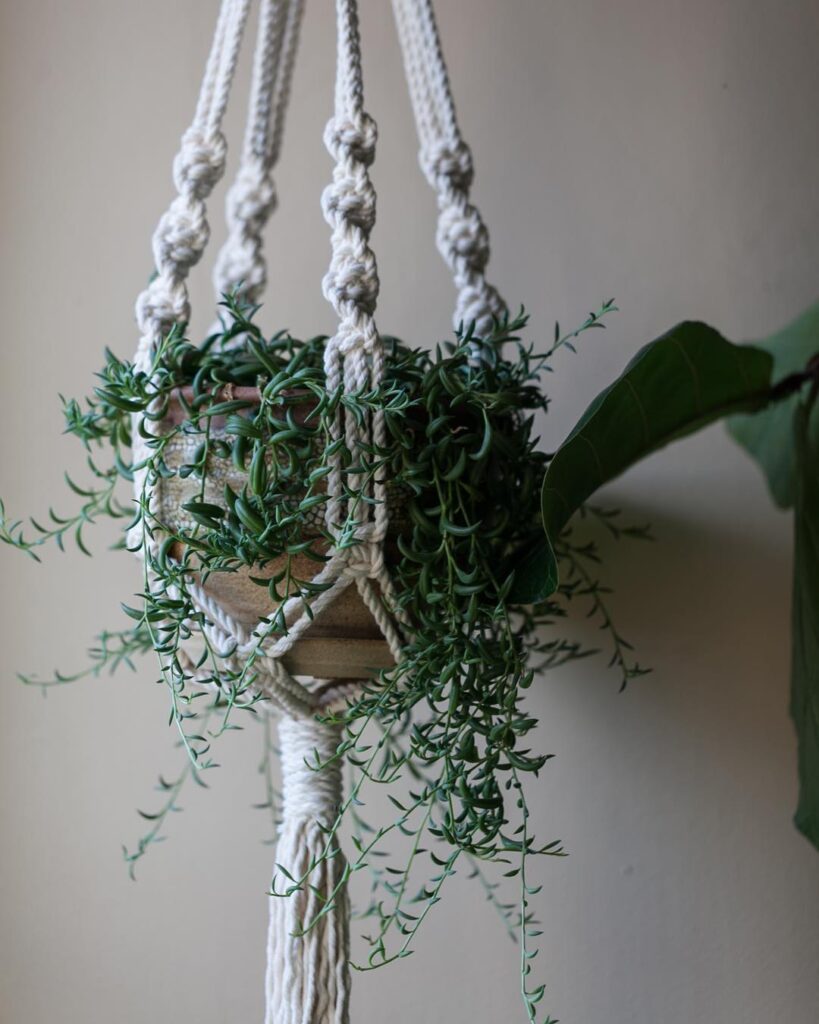
The String of Fishhooks (Senecio radicans) is a trailing succulent known for its curved, elongated leaves that resemble tiny fishing hooks. This South African native produces cascading stems that can grow up to 3 feet long, making it perfect for hanging baskets. Its fleshy, blue-green leaves grow densely along thin stems, creating an elegant waterfall effect, while small white flowers may appear in late winter or early spring.
- Light: Bright, indirect sunlight; can tolerate some direct morning sun but needs protection from harsh afternoon rays
- Water: Allow soil to dry completely between waterings; reduce watering in winter
- Soil: Well-draining cactus or succulent mix
- Temperature: 70-80°F (21-27°C); can tolerate down to 40°F (4°C)
- Humidity: Low to moderate; tolerates average household humidity
- Container: Pot with drainage holes
- Fertilizer: Light feeding with balanced fertilizer during growing season
- Propagation: Easily propagated through stem cuttings
4. Trailing Jade Plant
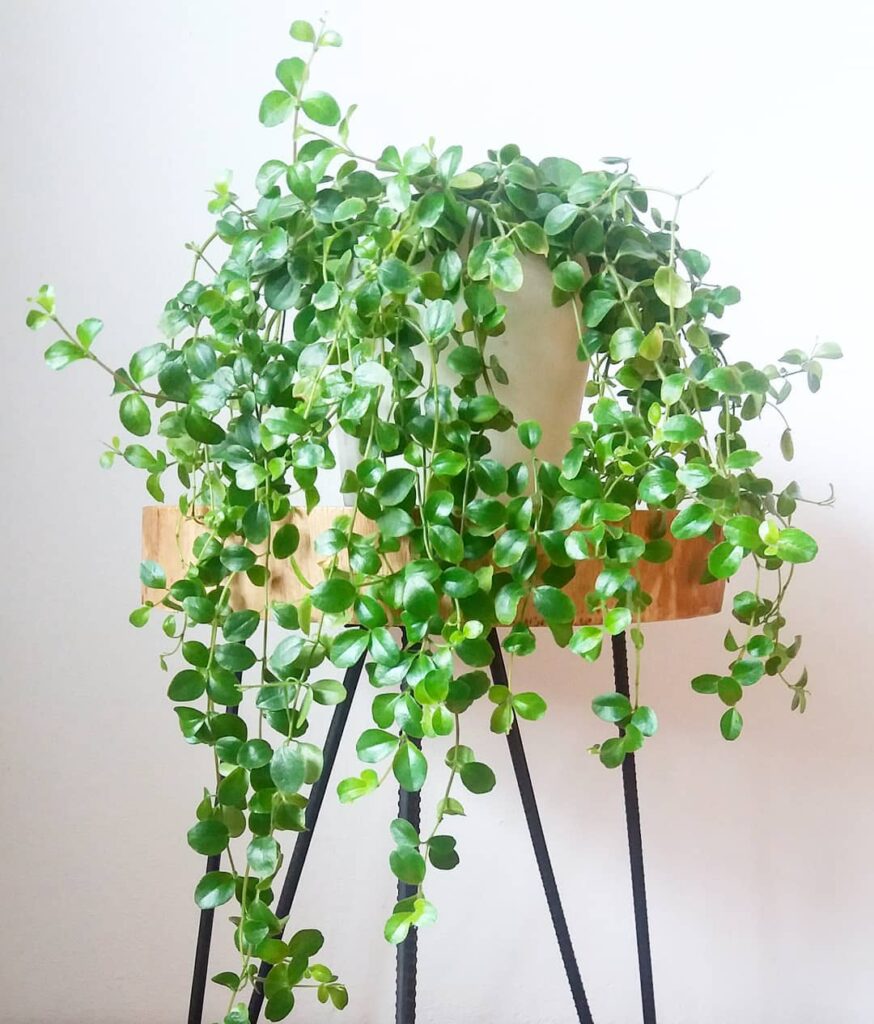
Trailing Jade Plant (Peperomia rotundifolia) is a delicate succulent featuring small, round leaves that cascade gracefully from hanging baskets. Unlike its namesake, the common jade plant, this variety has thin, flexible stems that can grow up to 12 inches long. The fleshy, bright green leaves are arranged in pairs along the stems, creating an attractive trailing effect that makes it perfect for hanging displays.
- Light: Bright, indirect light; can tolerate some morning sun but needs protection from harsh afternoon rays
- Water: Allow soil to dry between waterings; reduce watering in winter
- Soil: Well-draining succulent mix or regular potting soil amended with perlite
- Temperature: 65-75°F (18-24°C)
- Humidity: Moderate to high; tolerates average household humidity
- Fertilizer: Feed with diluted balanced fertilizer every 2-3 months during growing season
- Container: Hanging basket with drainage holes
- Propagation: Easily propagated through stem cuttings
5. Cascading Ruby Necklace Plant

The Ruby Necklace Plant (Othonna capensis) is a striking trailing succulent featuring delicate, string-like stems adorned with small, cylindrical purple-red leaves that intensify in color with sun exposure. This cascading beauty can grow up to 3 feet long, creating a dramatic waterfall effect as its stems spill over the edges of hanging containers. The plant also produces small, daisy-like yellow flowers throughout the growing season, adding an extra pop of color to its already attractive appearance.
- Light: Full sun to partial shade; needs at least 6 hours of bright light daily for best color
- Water: Low water needs; allow soil to dry completely between waterings
- Soil: Well-draining succulent or cactus mix
- Temperature: Thrives in 60-80°F (15-27°C); not frost hardy
- Humidity: Tolerates low humidity
- Fertilizer: Light feeding during growing season with balanced succulent fertilizer
- Container: Hanging basket or container with drainage holes
- Propagation: Easily propagated from stem cuttings
6. Trailing String of Hearts
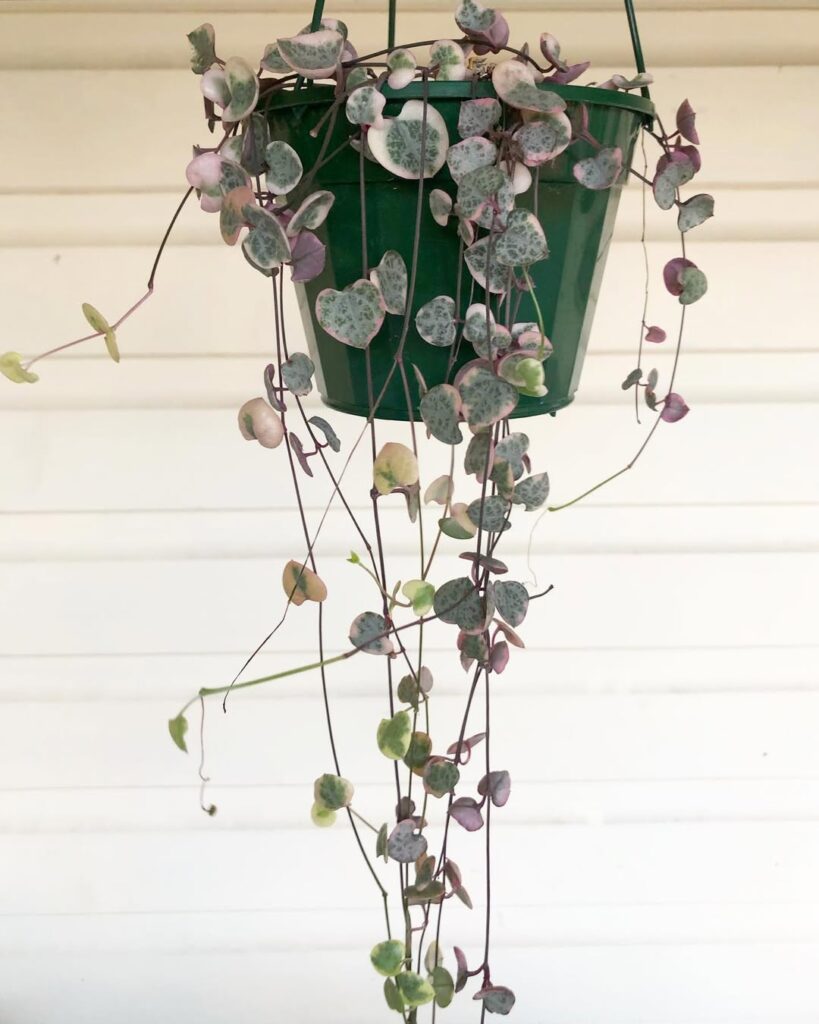
String of Hearts (Ceropegia woodii) is a delicate trailing succulent featuring long, slender purple stems adorned with small heart-shaped leaves in variegated patterns of green, silver, and purple. This charming plant can grow several feet long, making it perfect for hanging baskets where its dainty chains of foliage can cascade freely. Native to South Africa, this low-maintenance succulent produces tiny tubular flowers that resemble miniature lanterns, adding to its ornamental appeal.
- Light: Bright indirect light to partial sun; protect from intense afternoon sun
- Water: Allow soil to dry between waterings; reduce watering in winter
- Soil: Well-draining succulent or cactus mix
- Temperature: 65-80°F (18-27°C); not frost tolerant
- Humidity: Tolerates average household humidity
- Fertilizer: Light feeding with balanced fertilizer during growing season
- Container: Pot with drainage holes; hanging baskets or elevated planters ideal
- Propagation: Easily propagated through stem cuttings or tubers
7. Monkey Tail Cactus
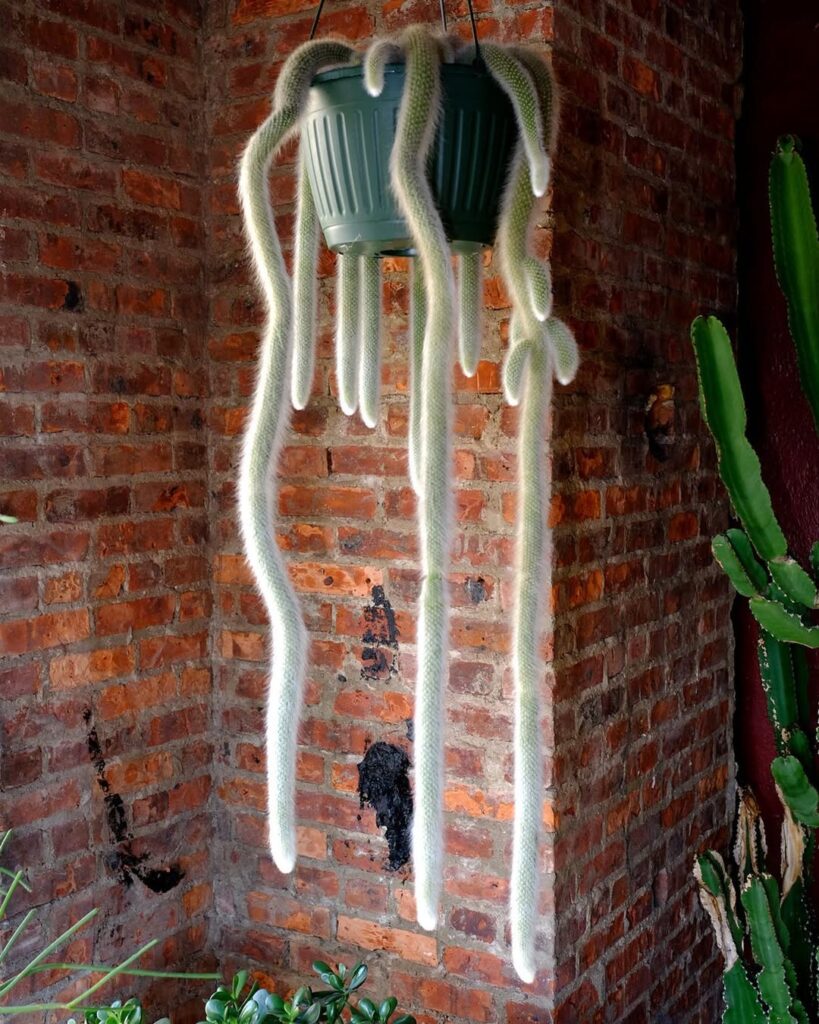
The Monkey Tail Cactus (Hildewintera colademononis) is a unique trailing succulent known for its long, tail-like stems covered in soft white spines that give it a fuzzy appearance. Native to Bolivia, this cactus can grow stems up to 3 feet long, making it perfect for hanging baskets where its distinctive pendulous arms can cascade downward. The plant occasionally produces large, white, nocturnal flowers, though blooming is rare in cultivation.
- Light: Bright, indirect sunlight; can tolerate some direct morning sun but needs protection from harsh afternoon rays
- Water: Allow soil to dry completely between waterings; reduce watering considerably in winter
- Soil: Well-draining cactus mix with added perlite or pumice
- Temperature: Prefers 65-80°F (18-27°C); not frost-tolerant
- Humidity: Tolerates average household humidity
- Fertilizer: Feed with diluted cactus fertilizer during growing season (spring and summer)
- Container: Must have drainage holes and be sized appropriately for the plant’s root system
8. Knotted Chain Crassulata
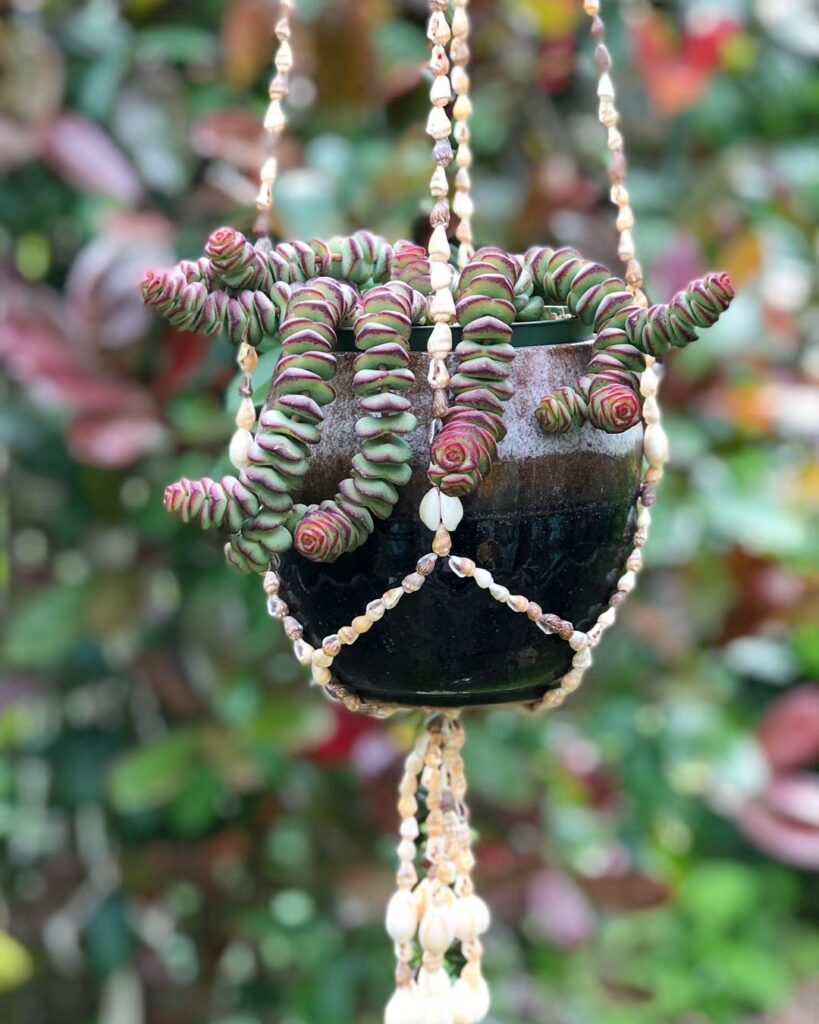
The Knotted Chain Crassulata (Crassula rupestris) is a trailing succulent characterized by its distinctive rope-like stems adorned with tightly packed, opposite pairs of fleshy leaves. These small, triangular leaves stack closely together along the stems, creating an appealing chain-like appearance that makes it perfect for hanging baskets. The plant produces clusters of tiny star-shaped white or pink flowers in spring, adding to its ornamental value. Its cascading growth pattern can reach lengths of up to 12 inches, making it an excellent choice for vertical gardens and hanging displays.
- Light: Bright, indirect sunlight; can tolerate some direct morning sun but needs protection from harsh afternoon rays
- Water: Allow soil to dry completely between waterings; reduce watering in winter
- Soil: Well-draining cactus or succulent mix
- Temperature: Prefers 60-75°F (15-24°C)
- Humidity: Low to moderate; tolerates average household humidity
- Container: Must have drainage holes
- Fertilizer: Light feeding with balanced fertilizer during growing season only
- Propagation: Easily propagated through stem cuttings
9. Calico Kitten Succulent
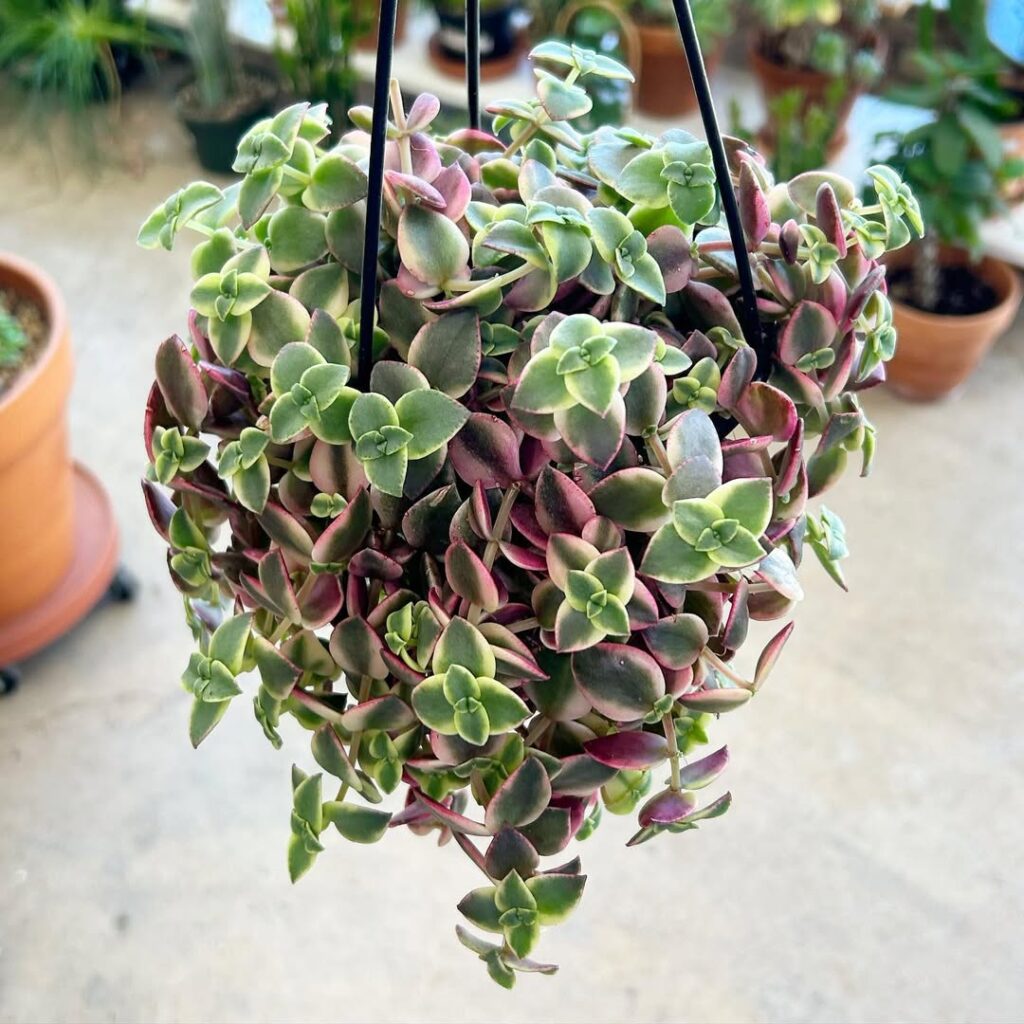
The Calico Kitten succulent (Crassula pellucida variegata) is a trailing succulent with delicate, heart-shaped leaves that display a stunning mix of pink, cream, and green colors. This petite plant cascades beautifully from hanging baskets, with stems that can grow up to 12 inches long. The leaves are small and rounded, growing in opposing pairs along slender stems, and they tend to take on deeper pink hues when exposed to more sunlight or during cooler temperatures.
- Light: Bright, indirect sunlight; morning sun with afternoon shade is ideal; protect from intense afternoon sun
- Water: Allow soil to dry completely between waterings; reduce watering in winter
- Soil: Well-draining succulent or cactus mix
- Temperature: Thrives in 60-75°F (15-24°C); not frost tolerant
- Humidity: Low to moderate; tolerates average household humidity
- Container: Requires drainage holes; ideal for hanging baskets or containers
- Fertilizer: Light feeding with balanced fertilizer during growing season
- Propagation: Easily propagated through stem cuttings
10. Trailing Dolphin Plant
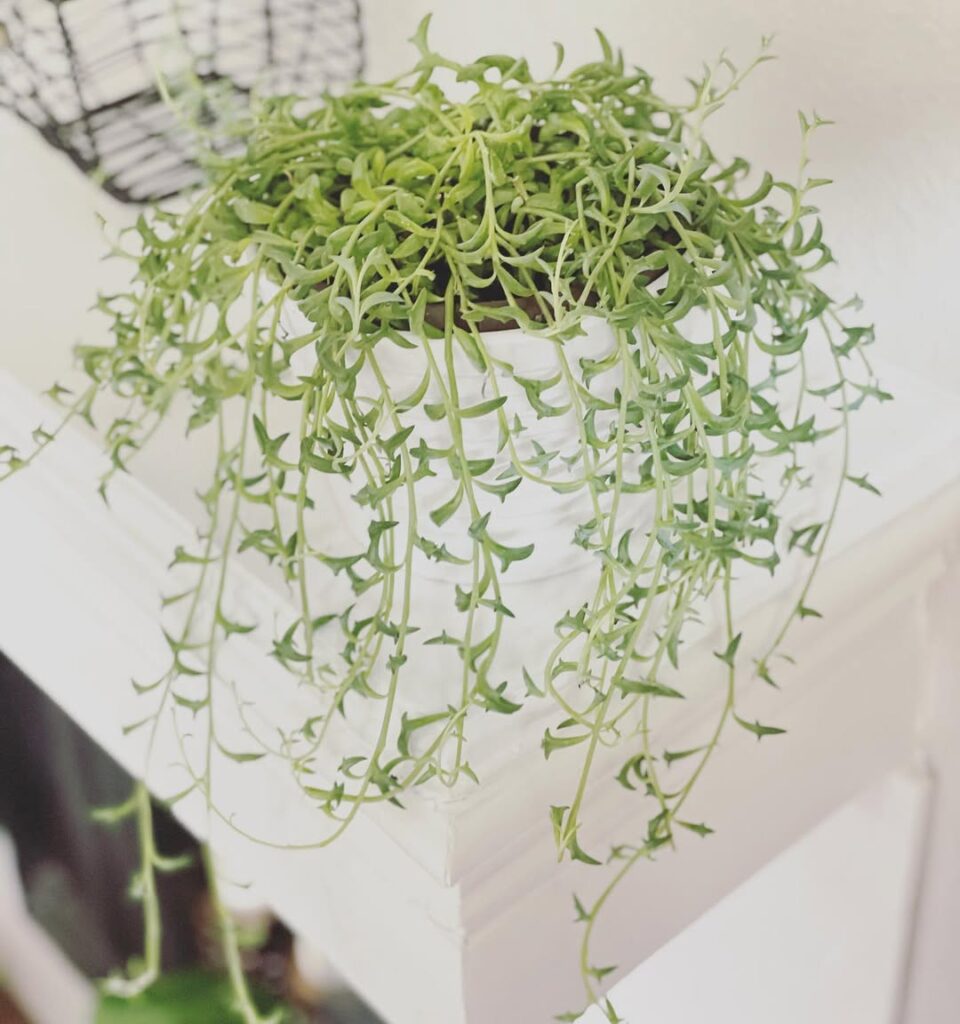
The Trailing Dolphin Plant (Senecio peregrinus) is a unique succulent known for its distinctive leaves that resemble tiny jumping dolphins. This charming trailing plant features small, curved, bluish-green leaves growing along thin stems that cascade gracefully over the edges of hanging containers. Its delicate appearance and manageable growth rate make it an excellent choice for hanging baskets, where the dolphin-shaped leaves can be fully appreciated as they spill downward.
- Light: Bright, indirect sunlight; protect from harsh afternoon sun; can tolerate some direct morning sun
- Water: Allow soil to dry between waterings; reduce watering in winter; sensitive to overwatering
- Soil: Well-draining succulent or cactus mix
- Temperature: 65-75°F (18-24°C); not frost tolerant
- Humidity: Moderate to low humidity; tolerates average household conditions
- Container: Must have drainage holes; hanging baskets or elevated pots ideal
- Fertilizer: Light feeding with balanced fertilizer during growing season only
11. Dancing Bones Succulent
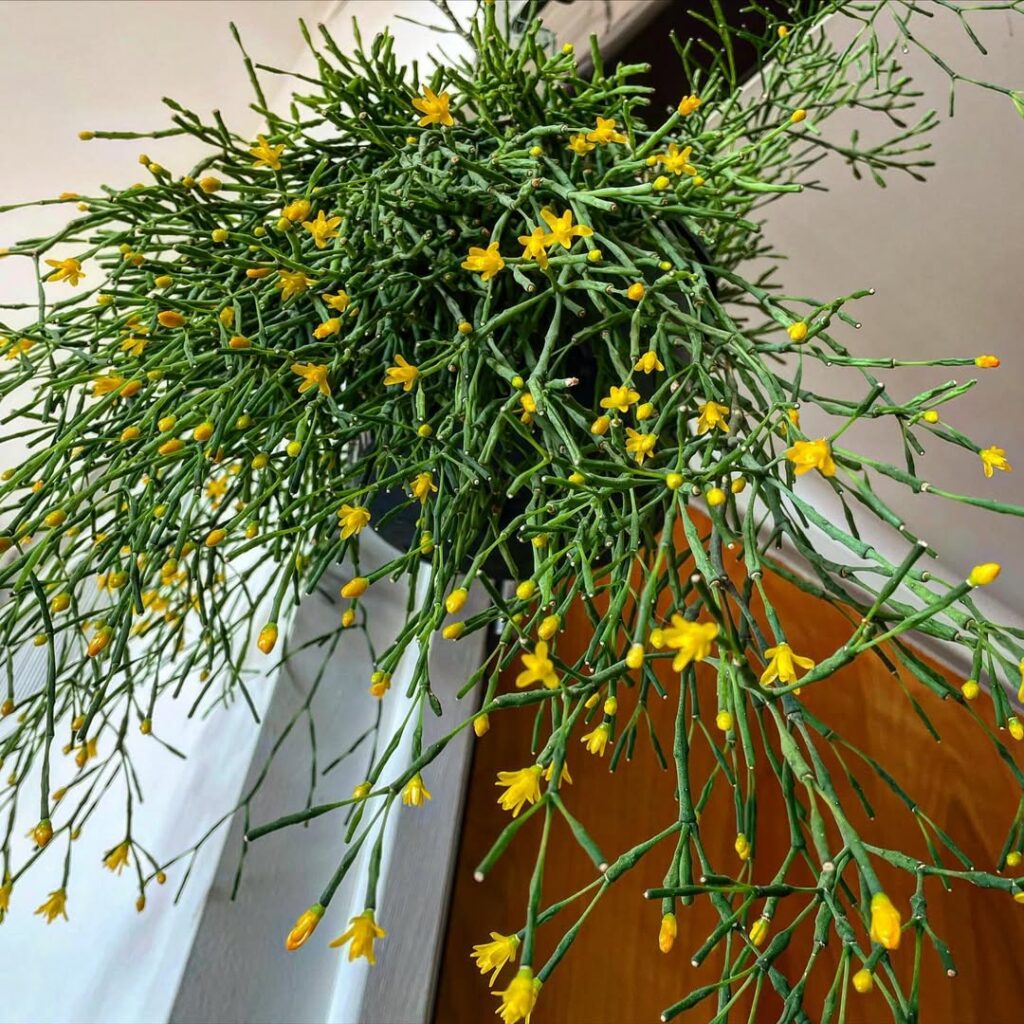
The Dancing Bones Succulent (Hatiora salicornioides) is a unique epiphytic cactus featuring slender, cylindrical stems that branch out in segments, creating a distinctive hanging appearance that resembles small bones or coral. This compact succulent typically grows 12-24 inches long, producing tiny yellow flowers in spring and small whitish fruits. Its segmented stems can vary from bright green to reddish-brown, depending on light exposure, making it an eye-catching choice for hanging baskets.
- Light: Bright, indirect sunlight; protect from intense afternoon sun
- Water: Water thoroughly when soil is nearly dry; reduce watering in winter
- Soil: Well-draining cactus mix with added organic matter
- Temperature: 60-80°F (15-27°C); not frost tolerant
- Humidity: Moderate to high humidity (50-60%)
- Fertilizer: Feed with balanced, water-soluble fertilizer during growing season
- Container: Hanging pot with drainage holes
- Propagation: Easily propagated through stem cuttings
12. Hanging Rat Tail Cactus
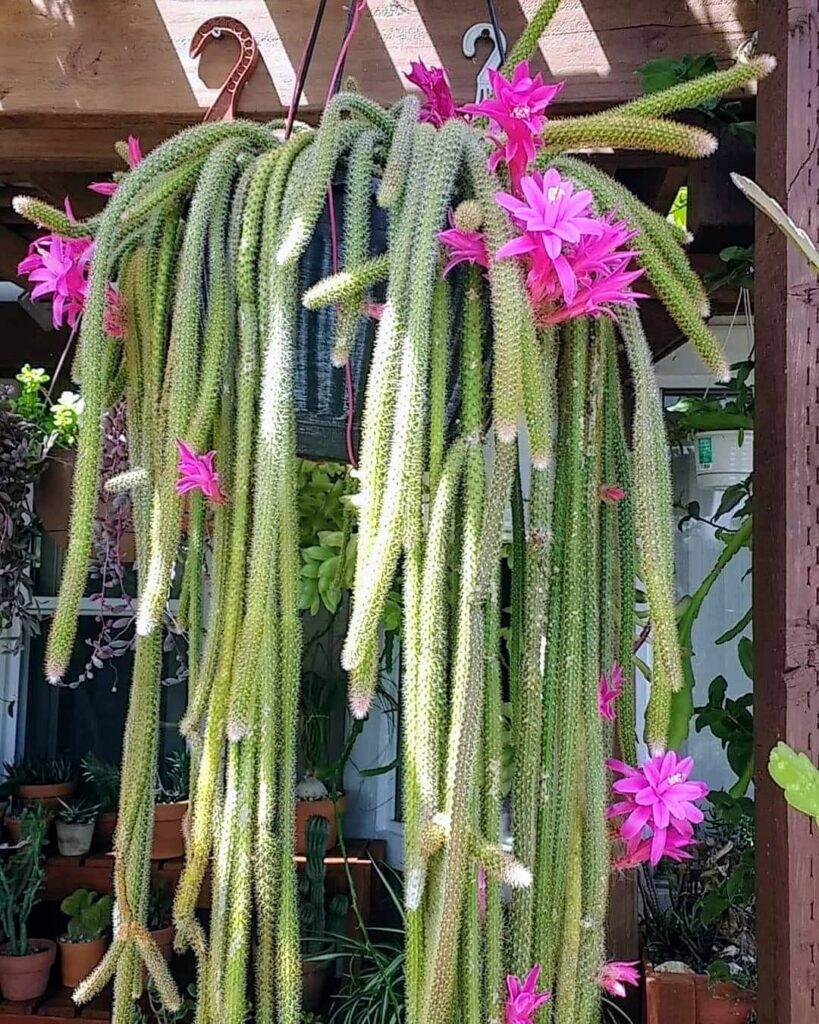
The Rat Tail Cactus (Aporocactus flagelliformis) is a unique trailing succulent with long, slender stems that cascade down like tails, making it perfect for hanging baskets. This epiphytic cactus produces vibrant pink to red tubular flowers in spring, creating a stunning display against its deep green trailing stems that can grow several feet long. The stems are covered in small, harmless spines and can become quite dense over time, forming an impressive curtain-like effect.
- Light: Bright, indirect sunlight; can tolerate some direct morning sun but needs protection from harsh afternoon rays
- Water: Allow soil to dry between waterings; water more frequently during growing season and reduce in winter
- Soil: Well-draining cactus mix with added perlite or pumice
- Temperature: Prefers 70-80°F (21-27°C); protect from frost
- Humidity: Tolerates average household humidity
- Container: Use hanging baskets with drainage holes
- Fertilizer: Feed with diluted cactus fertilizer during growing season
- pH: 6.0-7.0
Got it! Here’s another trailing succulent to replace String of Bananas:
13. String of Nickels
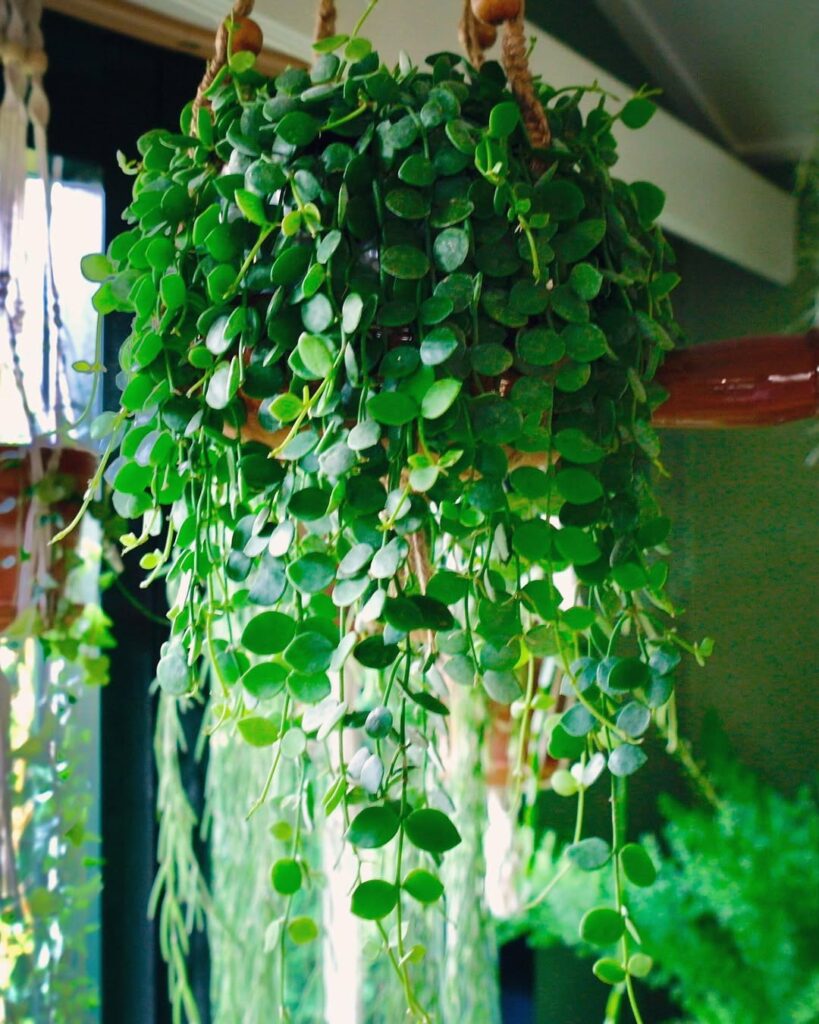
The String of Nickels (Dischidia nummularia) is a charming trailing succulent with round, coin-like leaves that cascade elegantly from hanging baskets. Its thick, fleshy foliage stores water, making it drought-tolerant and easy to care for. This plant thrives in warm, humid environments and can develop small, delicate flowers under ideal conditions.
- Light: Bright, indirect sunlight; tolerates lower light conditions
- Water: Allow soil to dry between waterings; prefers slightly moist soil in humid environments
- Soil: Well-draining mix with added orchid bark or perlite
- Temperature: Prefers 65-80°F (18-27°C); protect from frost
- Humidity: Prefers higher humidity levels
- Container: Use hanging baskets with drainage holes
- Fertilizer: Feed with diluted succulent fertilizer during growing season
- pH: 5.5-6.5
Here are three more trailing stween waterings; water more frequently in the growing season
Soil: Well-draining succulent mix with added perlite or sand
Temperature: Prefers 65-80°F (18-27°C); protect from frost
Humidity: Tolerates average household humidity
Container: Use hanging baskets with drainage holes
Fertilizer: Feed with diluted succulent fertilizer during growing season
pH: 6.0-7.0
14. Fishbone Cactus
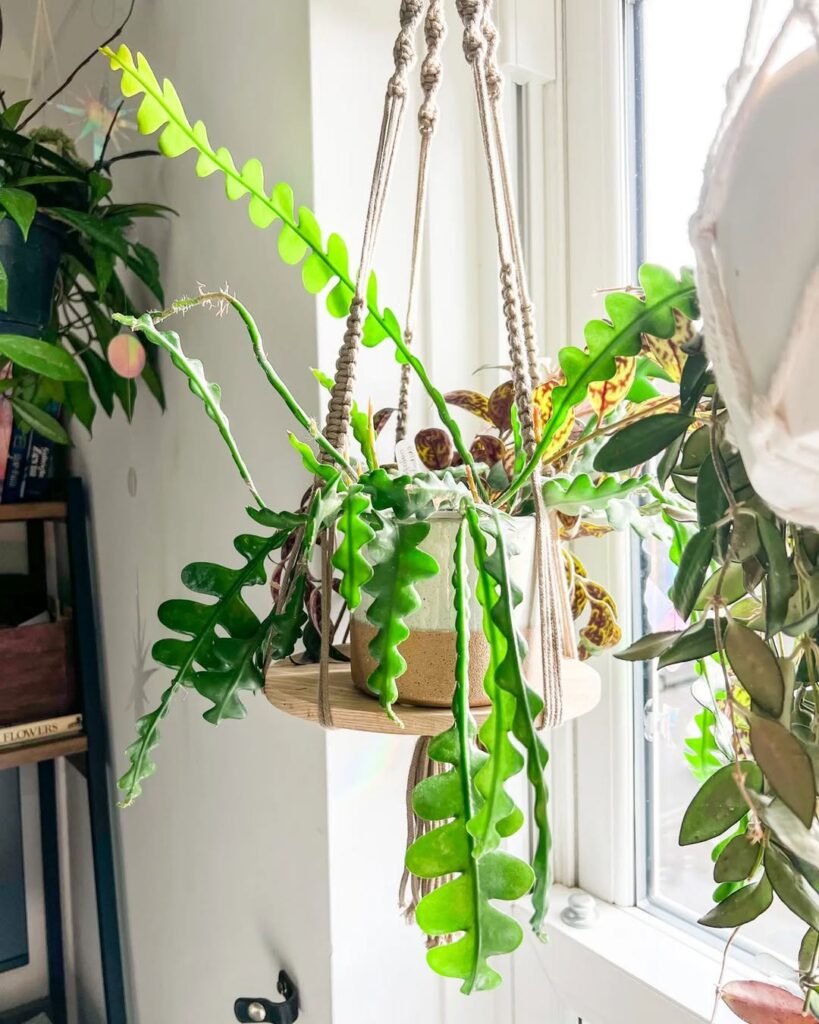
The Fishbone Cactus (Epiphyllum anguliger), also known as the Zigzag Cactus, features unique, wavy stems that resemble fishbones. This epiphytic cactus thrives in hanging baskets, where its long, arching stems can spill over beautifully. It produces stunning, fragrant white flowers that bloom at night.
- Light: Bright, indirect sunlight; tolerates lower light conditions
- Water: Keep soil slightly moist but allow it to dry between waterings
- Soil: Well-draining cactus mix with added orchid bark or perlite
- Temperature: Prefers 60-80°F (16-27°C); protect from frost
- Humidity: Prefers higher humidity levels
- Container: Use hanging baskets with drainage holes
- Fertilizer: Feed with diluted cactus fertilizer during growing season
- pH: 5.5-6.5
15. Peanut Cactus
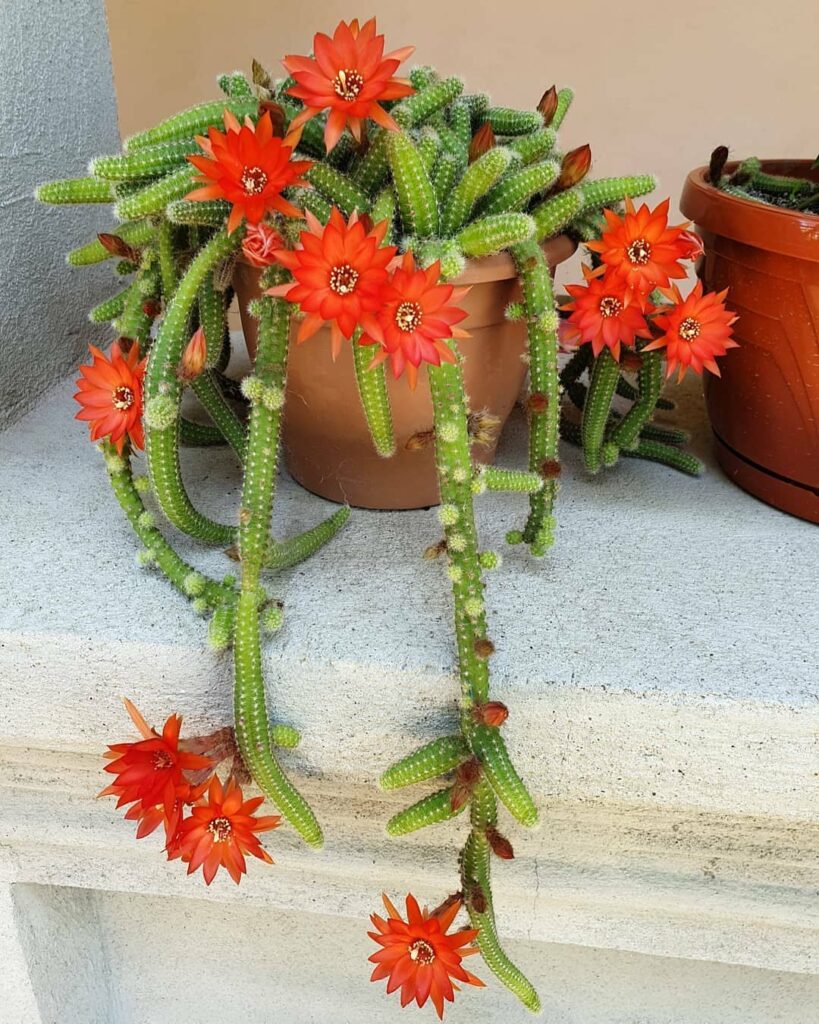
The Peanut Cactus (Echinopsis chamaecereus) is a compact, trailing cactus with slender, finger-like stems covered in soft, harmless spines. It thrives in hanging baskets, where its stems can drape elegantly. In spring and summer, it produces vibrant orange-red flowers that contrast beautifully with its green stems.
- Light: Bright, indirect sunlight; tolerates some direct morning sun
- Water: Allow soil to dry between waterings; water more frequently in the growing season
- Soil: Well-draining cactus mix with added sand or perlite
- Temperature: Prefers 65-80°F (18-27°C); protect from frost
- Humidity: Tolerates average household humidity
- Container: Use hanging baskets with drainage holes
- Fertilizer: Feed with diluted cactus fertilizer during growing season
- pH: 6.0-7.0
